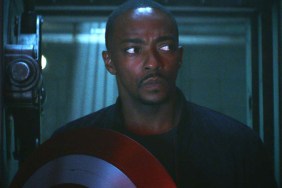
Paul Greengrass‘ Captain Phillips runs approximately 134 minutes long and as an audience member you feel pretty much every minute of that running time. However, it’s the final 10-15 minutes where you stop being aware you’re actually watching a movie and are thoroughly entrenched in the ordeal at hand.
Based on the true story of the titular commander of the U.S. container ship Maersk Alabama, which was hijacked in 2009 by a crew of Somali pirates, there is an ebb and flow to Captain Phillips that does result in some down moments. The plot occasionally seems to be spinning in circles and small portions could have been snipped, but by the time the credits roll you’ll only be left thinking of the devastating state you were left in with everything else just a blur.
While the two films don’t bear an immediate resemblance, Captain Phillips finds kinship with Zero Dark Thirty, both of which share a similarly impressive sense of authenticity and appreciation for realism. This works both in the former’s favor and to its detriment, as Greengrass can sometimes stick a little too close to the details, forgetting the story doesn’t have the typical pulse of an action film with dramatic highs and lows and a trip to the engine room isn’t quite as taut as it probably should be.
Once the band of four Somali pirates, led by Barkhad Abdi as Muse (pronounced MOO-seh), board Phillips’ ship, a wealth of time seems to pass before much actually happens. Ultimately, a questionable bit of decision making results in Phillips being held hostage aboard a lifeboat with the four pirates, hoping to reach the Somali shore before the U.S. Navy puts an end to their plans.
In telling the story, screenwriter Billy Ray (The Hunger Games, State of Play) isn’t interested in painting the U.S. crew as the good guys and the Somalis as bad. Instead he draws a thematic line, exploring the whys behind the Somalis’ motivations and the life they have waiting for them back home even if they successfully carry out their mission.
Alternatively, Phillips has a crew he must protect and a family waiting for him, which brings me to one dramatic misstep the film makes, which is to only offer a glimpse of Phillips’ home life. We see an email being sent and him asking whether his wife (Catherine Keener) is aware of his predicament, but in the end it’s difficult to feel much emotion for that portion of the story.
While kudos are due Greengrass and the likes of cinematographer Barry Ackroyd (The Hurt Locker) and a surprisingly effective score from Henry Jackman, most of the credit belongs to the actors as far as I’m concerned.
Tom Hanks is stellar in the title role, a role requiring he maintain his cool for most of the duration, which is why his fear and bewilderment the rest of the time is so powerful. On the other side of the equation is Abdi as Muse and his three cohorts Barkhad Abdirahman, Faysal Ahmed and Mahat M. Ali, four first time feature actors chosen out of a Minneapolis casting call, all of which bring their own level of humanity to the feature.
Abdi wears the plight of the entire Somali community on his face. Determined, scared and without a choice, Muse is caught more than once in moments where he must defy better logic and others where he must defy his own people. At a pivotal moment, with two U.S. Navy battleships and one aircraft carrier staring him down out the back window of his tiny lifeboat, Phillips tells him he must give up. He looks at him and says, “I can’t, I’ve come too far.” I’m not even sure he needed to say the words, as we’re left to feel his struggle in his every blink and swallow.
The entire supporting cast deserves credit, but I also must call out Navy Hospital Corpsman Danielle Albert who plays a pivotal role in the film’s finale and likely one that will be infrequently mentioned, though it’s every bit as deserving of praise and Oscar consideration as anyone else in the film. Playing what essentially amounts to the role she played in the actual events portrayed on screen, I’m positive the final moments of Captain Phillips wouldn’t have nearly the weight they do without her participation. We’re always so quick to give credit to the bigger name actors, well here is an instance where someone without any training or credits to her name elevates a scene into the stratosphere.
If you couldn’t tell by now, it’s the third act of this film that delivers the goods and you’re likely to read and hear the same from anyone else willing to offer an opinion. Quite frankly, these last minutes are near perfect. There are, however, a few pacing issues over the course of this lengthy picture and times where I found myself in a position where the film wasn’t nearly as tense as it should have been and even emotionally cold at points.
I occasionally found myself looking at Hanks not as Phillips, but as an actor playing a role. The threat sometimes lost its sense of realism because Greengrass occasionally allows us a little too much time to consider what we’re looking at and not moving the story along. These moments were few and far between, but they occurred nevertheless.
All in all, what you’ll walk away from Captain Phillips remembering is the overwhelming power of the final moments, the stand-out performances and your sense of relief met with a similar feeling of grief at what was necessary to end the ordeal at hand.









